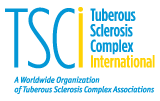Eyes
Manifestations
The appearance of retinal lesions varies from the classic mulberry lesions adjacent to the optic disk to the more common plaque-like hamartoma. Retinal hamartomas are occasionally noted in individuals without other manifestations of tuberous sclerosis complex (TSC) and in individuals with other disorders. Therefore, although they are suggestive of TSC, single lesions are not diagnostic of TSC.
The frequency of retinal hamartomas in individuals with TSC has varied in reports from almost negligible to 87 percent of individuals, a difference probably reflecting the technique used and the expertise of the examiner. Although less common than the retinal hamartoma, a defect in the pigment of the iris has also been observed in some individuals with TSC. In addition, white depigmented patches, reminiscent of the hypopigmented macules on the skin, have also been observed on the retina of some individuals with TSC.
Diagnostic testing and follow-up
Retinal lesions may be difficult to identify without pupillary dilation and indirect ophthalmoscopy, particularly difficult to examine in uncooperative children. Most retinal hamartomas remain dormant, although occasionally individuals with TSC have visual impairment resulting from a large hamartoma in the macular region. Instances of visual loss following retinal detachment, vitreous hemorrhage, or hamartoma enlargement are rare.
Treatment
For the most part, treatment of the retinal lesions and repeated ophthalmologic examinations are unnecessary. Normal eye care should be maintained.
INFO EYE INVOLVEMENT IN TSC [PDF]
This information © of the Tuberous Sclerosis Alliance and used with permission 2014. All rights reserved.

